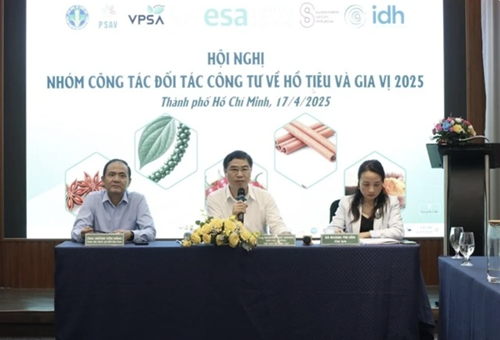Speaking at the 2025 Annual Public-Private Partnership Group Conference organized by the Vietnam Pepper and Spice Association, Le Viet Anh, the VPSA’s chief of office, reported that in the first quarter Vietnam exported 39,853 tonnes of black pepper and 7,807 tonnes of white pepper for 326.6 million USD.
    |
 |
|
Delegates at the 2025 Annual Public-Private Partnership Group Conference held in HCM City on April 17 |
It represented a 16.1% drop in volume but a 38.6% jump in value year-on-year on the back of soaring global prices.
The US remained Vietnam’s largest buyer despite a 32.6% drop in volume to 10,278 tonnes, accounting for 25% of export value.
Other top markets included India (3,370 tonnes, down 11.2%), Germany (3,358 tonnes, down 9.3%), and the UAE (2,757 tonnes, up 15.2%).
Shipments to China jumped by 87.8% to 2,034 tonnes.
According to the association, the industry is facing significant headwinds, especially the US’s imposition of a 10% tariff and a 46% reciprocal tariff on certain Vietnamese goods.
Vietnam has a 90-day negotiation window during which Washington will not impose the reciprocal tariffs.
VPSA Chairwoman Hoang Thi Lien said: “Businesses are cautious and holding off major export decisions while awaiting the outcome of the negotiations.
“If the negotiations fail to bring down tariffs, Vietnamese exporters could lose market share in the US to Brazil and Indonesia.
“The pepper industry is hoping that the Government will negotiate to reduce the reciprocal tariffs to the lowest possible levels.”
She urged businesses to maximize delivery during the 90-day grace period and proactively explore alternative markets like Europe, Asia and the Middle East.
“If, after negotiations, the countervailing tariffs on Vietnamese pepper remain higher than those of competitors, Vietnam’s market share in the US will likely shrink.”
The VPSA said total pepper imports of European countries in 2024 increased by 20% compared to 2023 to 120,657 tonnes. Vietnam's share of pepper exports to Europe also steadily increased over the years, rising from 44.6% in 2022 to 51.1% in 2023 and 52.1% in 2024.
It noted that the EU remains a highly demanding market with stringent quality, traceability and technical compliance requirements, especially for premium products like white and organic pepper, meaning Vietnamese exporters must constantly improve their quality.
Sustainability and public-private cooperation
Huynh Tien Dung, country director of IDH Vietnam (Initiative for Sustainable Trade in Vietnam), highlighted the joint efforts made by the Public-Private Partnership Working Group on Pepper and Spices in the past year for supporting sustainable pepper and spices production.
This year marks the conclusion of the group’s 2021–2025 strategic phase, during which progress has been made in improving farming practices, building farmer capacity, fostering dialogue between public and private sectors, and strengthening ties with international industry associations like the European Spice Association and the American Spice Trade Association, he said.
Looking ahead, the pepper sector faces ongoing risks, from inflation and geopolitical instability to increasing market demands for transparency, traceability and sustainable practices, trends that make it more important than ever to reinforce cooperation frameworks and develop a resilient strategy for 2026–2030, he said.
He shared IDH's vision for the next strategic phase: boosting commercial value through quality improvement, traceability and income diversification, particularly by promoting intercropping of pepper and coffee in the Central Highlands. It also aims to stabilize smallholder livelihoods by integrating sustainable production systems and expanding market and financial access, enhance environmental resilience by promoting regenerative agriculture, increasing carbon absorption, improving biodiversity, and enabling more accurate emissions tracking across pepper–coffee intercropping systems.
Source: VNA